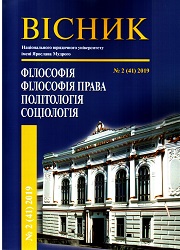ВІЗУАЛІЗАЦІЯ ПОЛІТИЧНИХ ВІДНОСИН ЗАСОБАМИ АРХІТЕКТУРИ
VISUALIZATION OF POLITICAL RELATIONS BY THE MEANS OF ARCHITECTURE
Author(s): Ievhen Viktorovych Pereguda, Nadiia Anatoliivna HerbutSubject(s): Architecture, Civil Society, Social development, Social Theory, Rural and urban sociology, Politics of History/Memory
Published by: Національний юридичний університет імені Ярослава Мудрого
Keywords: symbol; symbolic policy; visualization; architecture; consciousness;
Summary/Abstract: Problem setting. The architecture has the powerful potential of impact on political consciousness of citizens. This role is reinforced due to the development of high technologies, growing data streams, etc. The policy of national memory in Ukraine is the testimony of this phenomenon.Recent research and publications analysis. The researches, devoted to the relations between the architecture and politics, including the problem of human rights, are spread recently. The studying of architecture impact on formation of symbolic policy, are spread within Urban Studies. O. Hatherley, S. Low et al. study the impact of city squares on political communications. The significant contribution into study on impact of architecture on social relations was made by neuropsychologist C. Ellard. Some researchers have analyzed the political the political aspects of the government institutions architecture. N. Khoma develops the theoretical principles for political Urban Studies in Ukraine. However, there are the contradictions in national researches; they often pay attention only to reflection of tendencies for political development in architecture.Paper objective. The paper objective is to analyze the mutual impact of architecture and social political relations, in particular, architecture ability not only to reflect the tendencies in social political development but to impact on them.Paper main body. A symbol not only represents the social actuality, it is such actuality and it forms it within dynamic aspect. This stipulates not only the propagandist but social organizing functions of architecture. Hereby, the architectural objects produce the senses, which their creators have not anticipated. Moreover, they can change the symbolic load with time. The mechanism to form the actuality through symbolization is the embodiment of new sense into symbolic object by its consumer, and the discrepancies in perception relate to different social positioning of consumers. The theoretical substantiation of these phenomena is the concept by M. McLuhan, in particular, his principle according to which the medium is the message the medium is amputated from its creator. As a result of this, the architecture can refer to other actuality, namely to society with its range of persuasions, emotions, etc.The history of president’s residencies in Turkey is analyzed in the paper as the example for impact of form on development of political relations. Moving of the President to the new residence was preceded to constitutional implementation of president’s government. Place de la Concorde and Vendome Column in Paris were chosen as the example for change in information content of architectural objects. The authors explain the discrepancies in shapes for T. Shevchenko monuments in Ukraine with discrepancies in concepts of nation, which are defended by different regional communities in Ukraine.Conclusions of the research. The authors refer the perspectives for researches on role of architecture in formation of political relations to accumulation of actual material both as to symbolization of certain architectural elements and mechanisms to form the senses of architectural spaces.
Journal: Вісник НЮУ імені Ярослава Мудрого. Серія: Філософія, філософія права, політологія, соціологія
- Issue Year: 41/2019
- Issue No: 2
- Page Range: 20-37
- Page Count: 18
- Language: Ukrainian

